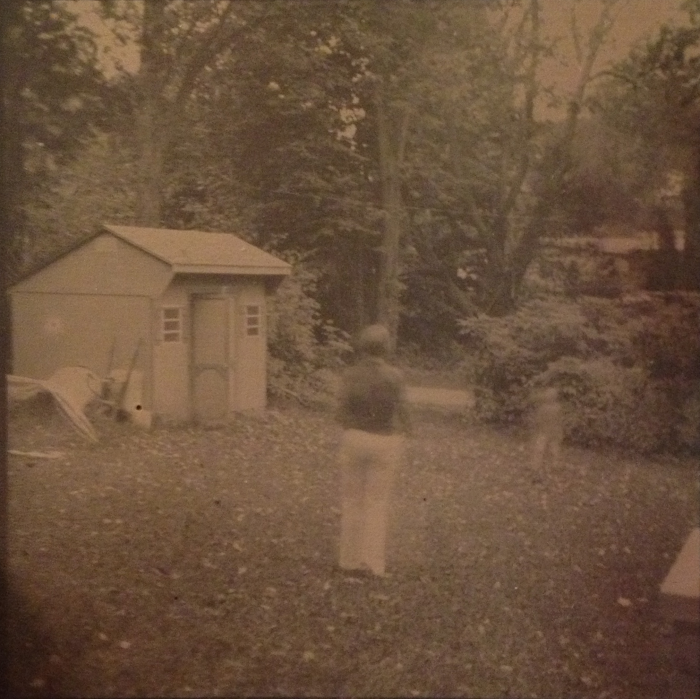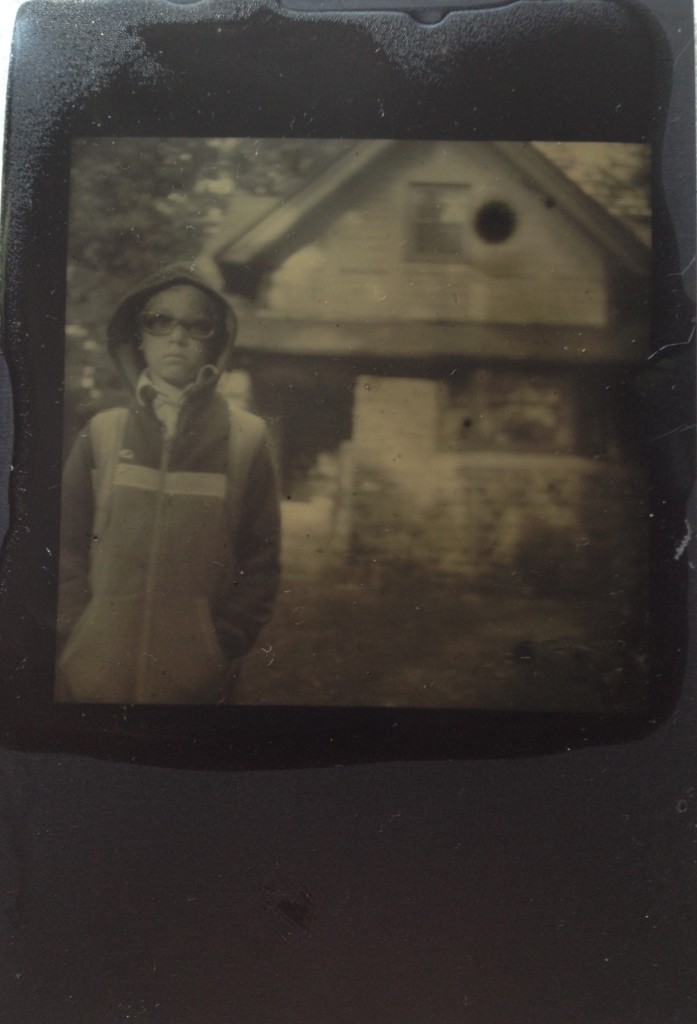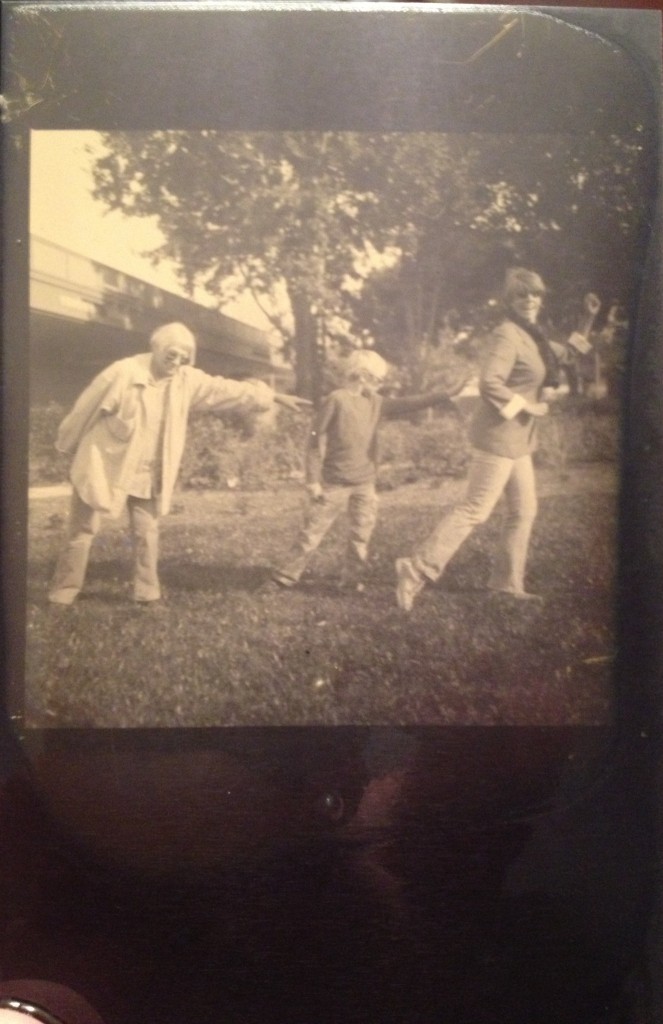Dry plate tintype
Over labor day weekend, I had a few photographers and alt-printers over for printfest 2013 – a chance for me to teach a little alt-photo, experiment a little, and for all of us to make some nice prints. Of course two of the participants had to bring large format gear, which I’ve been avoiding like the plague. Not for lack of interest, but for lack of money for me to do it right.
Worse: I held and shot a speed graphic 4×5. The only two ways out from here are to give in and spend a bunch of cash on LF, or to come up with a new distraction.
I decided on dry plate tintypes. (I figure I’m just postponing the inevitable, but any slowdown in the process is welcome at the moment.)
Rule 1: it had to be cheap.
I’ve got several medium format cameras around the house; a bunch of aluminum flashing from when our roof was last rebuilt; a can of black spray paint; and a $40 gift card for Amazon.
I rinsed off the plates, dried them, and gave them each two coats of flat black enamel. (Incidentally, this was the cheapest spray paint that was available at Home Depot a couple years ago when Jake and I were building a solar heater. More cheapness!) After drying, I cut the sheets (with a paper cutter) sized to fit in the back of a Ricoh Diacord TLR.
The gift card went to a bottle of Liquid Light, a gelatin emulsion by Rockland Colloid. They advertise a tintype kit, and have another emulsion that’s faster, but this was what was available from Amazon. I really didn’t want to spend any more money on it so I figured I’d whip up my own reversal developer, and see how things went.
I thought I might have to sub the plates to make the emulsion stick. I tested with various combinations and percentages of gelatin with chrome alum; polyurethane spray varnish; or no treatment at all. The only trouble I had with the emulsion coming off the plate was when I accidentally left one soaking in water overnight. (Whoops.) But, good news, no subbing necessary.
Next up: exposure. I guessed at about ISO one-half, and shot the above evening picture at 8 seconds, f/3.5.
Figuring out how to develop these plates turned out to be quite the challenge. I thought that surely the interwebs would have some knowledge of a reversal tintype developer for Liquid Light. In fact, not so much. I made a few test runs based on Dektol, and nothing really worked. I decided to save myself some agony and spend a little more scratch on the Rockland tintype kit, which comes with their developer. This turned out to be a good buy: after looking up the MSDS on their developer, I was able to perform some side-by-side testing of various recipes of my own until I wound up with a good alternative.
120mL stock, undiluted, Dektol
4g Ammonium Thiocyanate
This performs similarly – if not identically – to Rockland’s tintype developer. The Dektol immediately and rapidly attacks the silver halides, beginning to develop a negative; while the ammonium thiocyanate (a silver solvent) is somehow responsible for the last-minute reversal. My (probably flawed) understanding is that when UV light strikes silver halides, a small metallic silver grain is formed. Developers complete that reaction to the rest of the suspended clump of halide, providing that there’s enough metallic silver to cause the development to begin. So presumably, while the dektol is converting silver, the thiocyanate is dissolving it; until there are no more metallic silvers left, and the final halides (in the unexposed colloid) wind up becoming visible.
Anyway: fixing is trivial. Rockland also recommends a Kodak hardening fixer. I’ve been using Ilford’s Rapid Fixer without incident (again, what I had in the house).
Grand total expense: well, about $200. I wound up buying many things I didn’t actually need along the way, bumping up the cost, and then there were the shipping charges. Sigh.
- various polyurethanes
- Rockland’s tintype kit
- iron sulfate
- metol
- hydroquinone
But at least I also get to play with some Ag+ (Rockland’s “fast” emulsion), which comes in their tintype kit. More on that some other time…




Hi Jorj,
Thanks for the post- it’s very informative. I’m just getting into Tintypes – I tried the Rockland Kit – and am considering trying to get the ingredients myself. I was wondering if you had any updates on two things:
1. Have you used the AG Plus since this post and if so, how does it differ from Liquid Light? I too, am considering using an Amazon credit to order the Liquid Light, but I’m wondering if I’d get different (better) images with AG Plus rather than Liquid.
2. Have you learned anything further about your DIY Reversal Developer Recipe vs. the one supplied by Rockland Colloid? Any tweaks that make it better/worse? I’m considering making it myself since it’d be much cheaper but again, am worried that I’ll get an inferior image compared to Rockland’s developer?
Any help would be much appreciated! And keep up with the great work- you have some really cool images!
Kyle
Yes on both counts.
The Ag+ is faster and, not surprisingly, seems more finicky – the faster the emulsion the more careful you have to be with it (in general, not specifically Rockland products). I actually prefer the Liquid Light.
The two developers still seem nearly identical. I spent some time with different concentrations of ammonium thiocyanoate and 4g seems best. I’m working on homebrewing the dektol too, to see if I can make it completely from scratch. If that works I’m sure I’ll turn it in to a post of its own 🙂
I wanted to let you know I tried the formula for dry plate developer; it worked very well.
Thank you for posting this.